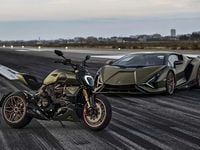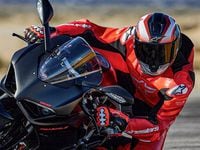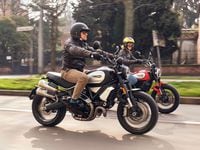Ducati’s Hypermotard 698 Mono is not an entry-level addition to the Hypermotard family. Yes, it’s the smaller-displacement, less-expensive alternative to the Hypermotard 950 V-twin, but it’s also a wicked, eye-opening extension of the family. It’s Ducati’s new approach to the street-legal supermoto category, made possible through an extreme emphasis on light weight, performance, and tech.
Unique as that approach is to Ducati, it’s not a substantially different approach than what KTM, Husqvarna, and GasGas have taken with their similarly spec’d but uniquely styled 690 SMC R, 701 Supermoto, and SM 700, which have been the go-to-big-bore option in the supermoto class. Those bikes—and now the Hyper 698 Mono—are designed to offer vastly more performance than entry-level options like the Kawasaki KLX300SM and Suzuki DR-Z400SM, which round out this much-loved but relatively niche, low-volume category.
If you’re wondering why Ducati decided to invest in a category with such limited competition, you’re not alone. Ducati says that the decision was born from the desire to create something fun and exciting (read: a passion project), which isn’t far from what you’d expect from the omni-passionate Italian firm. But that doesn’t tell the whole story.
The other, more likely reason is that Ducati wants to highlight the insane performance of the all-new Superquadro Mono single-cylinder engine that was actually unveiled ahead of the Hyper 698. What better way to showcase a new, high-performance single than in a supermoto that exists almost purely for unadulterated fun? To love the new Hypermotard 698 Mono will be to love the engine that gives the bike its personality.
How much personality is there (spoiler alert: a ton), and how does that play into the riding experience (ditto)? We headed to a kart track just outside Valencia, Spain—a proving grounds and training area for the local racing elite—to find out.
First, a look at what makes the new bike so hyper.
We should say bikes, or at least versions, as Ducati will sell a base-model Hypermotard 698 ($12,995) alongside a more stylish 698 Mono RVE, which has a “graffiti” livery and bidirectional quickshifter, but sets you back a little extra coin with its $14,495 msrp.
The bike is powered by an engine that’s loosely referred to as half of a 1299 Panigale engine, since much of its design and hardware comes from that iconic V-twin. Bore and stroke are an eye-opening 116.0 x 62.4mm, the former making room for the same valve diameters as in the 1299: 46.8mm titanium intakes and 38.2mm steel exhausts. The piston and combustion chamber shape are exactly as they were on the Panigale.
The desmodromic-equipped head uses a dedicated set of rocker arms and cam lobes to shift power into the midrange. Ducati claims 77.5 hp at 9,750 rpm and 46 lb.-ft. of torque at 8,000 rpm. More than 70 percent of the max torque is available at 3,000 rpm, and more than 80 percent between 4,500 and 10,250 rpm. A Termignoni exhaust drops 3.3 pounds and adds 7 hp.
Weight management was a key focus during design and therefore the Superquadro Mono uses magnesium engine covers and an aluminum cylinder sleeve, like what Ducati used on the 1299 Superleggera (the standard 1299 Panigale used steel). Total engine weight is 98.3 pounds, which is light, but, thanks most likely to the desmo valvetaine, still 2 pounds heavier than the claimed engine weight for the KTM, Husqvarna, and GasGas. Those engines also make more torque (a claimed 54 lb.-ft. at 6,500 rpm), but less peak power (74 hp @ 8,000 rpm).
Two balance shafts are used to cancel vibration, as is the case with the KTM-based competition, the only difference being that the Ducati’s balance shafts are both located in the crankcase (versus one in the head), since the desmodromic system reduces available space up top.
We wouldn’t normally draw so many comparisons between competing models, but given the focused scope and nearly identical figures, it makes sense here. For example, the Hyper has 26.1 degrees of rake and 4.2 inches of trail, which is easily comparable to the 26.4 degrees of rake and 4.2 inches of trail on the GasGas SM 700. The only big difference is in the wheelbase; Ducati opted for a shorter, 56.8-inch wheelbase compared to the 57.9-inch gap between the GasGas’ axles.
More weight-saving measures come in the form of cast aluminum wheels, which are 1.1 pounds lighter than equally sized spoked wheels, like what are found on the KTM and Husqvarna (the GasGas also rolls on cast wheels). Claimed wet weight (sans fuel) is 333 pounds, whereas most of the competition comes in at around 324 pounds dry. Weight differences will vary a bit more considering the Ducati has a smaller, 3.0-gallon gas tank, compared to 3.6 gallons on the GasGas. Small differences, but something to consider. Final judgment on weight will come on the Cycle World scale.
Suspension consists of a fully adjustable Marzocchi fork and fully adjustable Sachs shock. Front and rear suspension travel are 8.5 and 9.4 inches, respectively (same as on the GasGas), while the seat height measures a staggering 35.6 inches—0.2 inch more than the GasGas but 0.2 less than the Husqvarna, which has a taller seat height than its cousins.
More differences? The Ducati’s front brake disc is 10mm bigger than the competition’s, plus tied to a much more expansive electronics package that includes four ABS settings, for easier sliding. Or not, in case you’re still getting used to the whole supermoto thing and want to keep your wheels in line.
The electronics package also consists of lean-angle-sensitive Ducati Wheelie Control (four levels, plus off), Ducati Traction Control (eight levels, plus off), and Engine Brake Control (three levels). Ride modes include Sport, Road, Urban, and Wet.
Settings are adjusted via switches on the left-hand side of the handlebar and confirmed through a 3.8-inch LCD display that’s small but more stylish and modern than what you’ll find on the competition.
The rest of the bike’s design hints at its performance-first build. Lines are sharp, and cowlings are minimal. Compared to the bigger V-twin Hypermotards, this has a much more dirt-bike-like presence.
While we’ve ridden a handful of those V-twin-powered Hypermotards at the track, they always felt a bit out of place—too big for tight, technical kart tracks, but too pointed to accomplish anything at a proper racetrack. That’s fine considering that the plus-sized Hyper is intended to be more urban hooligan than track weapon, but also worth mentioning here, because the different design helps you better understand the Hyper 698 Mono’s intentions—and what you’re signing up for. No, the latter is not as sharp as a purpose-built, 450 motocrosser-turned-supermotard, but the gap between those two concepts feels smaller than was the case with any Hyper that came before it.
Most of that sensation comes from the spicy (and absolutely gorgeous) single-cylinder engine, which has more off-bottom grunt than the numbers and talk of “high-revving performance” suggests. Revs build quickly though, and you’re into the 10,250 rpm rev limiter sooner than expected. It’s a more lively, on-edge package than what we’ve experienced from the competition, and at the racetrack especially, it keeps you on your toes. There’s very little of that lumpy, big-bore single sensation down low.
A tall first gear means you’re not immediately into the rev limiter when leaving a stop, but with a light clutch pull, you have to be diligent with the throttle to make sure you don’t stall the bike as you motor out of the pits. Or probably more fittingly, as you pull away from a stoplight. Because let’s be honest, the vast majority of these bikes will spend most of their time on the street.
We spent a handful of laps cruising around the track at an around-town pace to better understand low-speed mannerisms, but there was nothing to suggest this engine was too hard-edged for casual riding. Thanks to those counterbalancers, vibration is kept to a respectable level.
That said, throttle response is pretty aggressive in Sport. Road offers a more manageable on/off transition and helps knock some of the edge off. Assuming you want to knock some of the edge off…
Steering is fast as you want with a short wheelbase and heavy front-end weight bias. It feels like you can flick the bike through tight right-left-right chicanes by just sneezing on the inside bar and peg, which, more importantly, means the bike should carve through city streets with ease. It’s usually on the right side of twitchy, with enough stability to feel comfortable in faster corners. The best part is front end feel at corner entry; it’s shocking how hard you can load the tire as you stab the brakes and pitch the bike into a turn.
Handling is not perfect though. As is the case with the engine, you can feel the chassis flirting with that line between predictable and on-edge, and it occasionally veers over the wrong side of that line. Things happen quickly, which makes you feel alive, but also like you’ve had a few too many Monsters and should try to calm down a bit. Then again, were supermotos ever meant to be mellow?
Tuning the suspension helps keep things in check. We tested stock settings in the morning and a setup with more preload and compression/rebound damping in the afternoon. The latter offered more stability and highlighted the suspension’s nice adjustment range, but given the long travel (good for weight transfer at the track), there’s always some movement through the fork and shock as you put inputs into the bike. A lighter and shorter rider (this test rider is 6-foot-3-inches and 210 pounds with gear) might have it a little easier.
Electronic rider aids provide an admirable safety net, with a level of refinement that you wouldn’t have found on a bike like this 10 years ago—or maybe even a literbike. Gone are the days where safety meant having to deal with aggressive ignition cuts. Now you have subtle intervention that prioritizes forward momentum, whether you’re on this, or a Panigale. Mind you, those electronics limit how much of a hooligan you can be, so adjust accordingly.
Speaking of, while we appreciate the dash’s added moderness over the competition, the display feels busy and leaves us wanting more. Supermotos are about simplicity, but if you’ve got ride modes and multiple electronic systems to adjust, bigger might just be better. The current, rather small display is difficult to read at a glance, and it takes time to get comfortable navigating the rider-aid settings.
The system we liked playing with most was ABS, which has a slide-by-brake feature specific to this bike. Depending on the mode (1 through 4) and bike positioning, the system adjusts ABS pressure to enable the rear tire to step out as you slide into a corner. The hard part? Granting enough trust in the system and not trying to override it with choppy inputs once a slide begins. We’ll get there, just not on day 1. That’s important to mention, because it’s also one of Ducati’s goals; to have enough performance and technology that riders can hone their skills and grow with the bike. This electronics package allows for that.
The idea of using a supermoto as a training tool is nothing new, but the reality is that Ducati’s bigger Hypermoto models were intended to evoke a feeling on the road more than fast laps around the local kart track. The Hypermotard 698 Mono is different in that it’s a legitimately good time at the track, and fully willing to be pushed to its limits. No plans to hit the track? No worries, that lighthearted personality will make it just as much fun to cruise around town on. That, of course, is about as much as you’ll probably want to subject yourself to. Fun as a supermoto might be, they aren’t winning any awards for long-range comfort or versatility, and that’s especially the case with this more pointed offering.
Rowdy is the name of the street-legal supermoto game though, and in the case of the Hypermotard 698 Mono, that’s exactly what you get.
Now, where will that Superquadro Mono engine end up next?
Helmet: Arai Corsair-X Nicky Reset
Racing Suit: Alpinestars Racing Absolute V2
Gloves: Alpinestars GP Tech V2 S
Boots: Alpinestars Supertech R










/cloudfront-us-east-1.images.arcpublishing.com/octane/XGKQ7UKGCNEAVAPT6NTLK247SI.jpg)
/cloudfront-us-east-1.images.arcpublishing.com/octane/6WKR3VGXBJBM7OE5E4D3EAPSM4.jpg)
/cloudfront-us-east-1.images.arcpublishing.com/octane/C4AEBC73UBEVZPHFSYBDDVNYKI.jpg)
/cloudfront-us-east-1.images.arcpublishing.com/octane/VBOM43G36NHNTEANXK24XJPHG4.jpg)
/cloudfront-us-east-1.images.arcpublishing.com/octane/GANUKASFYBG2XN3YF6E64A6A5I.jpg)
/cloudfront-us-east-1.images.arcpublishing.com/octane/OLFZVYEFEVEABJFCPHZMXURIQE.jpg)
/cloudfront-us-east-1.images.arcpublishing.com/octane/Z3C5M7SLTFGZHEU3LBEZ7NU63I.jpg)
/cloudfront-us-east-1.images.arcpublishing.com/octane/NC5E5AHGKZAKPKP4LP6XGABNME.jpg)
/cloudfront-us-east-1.images.arcpublishing.com/octane/IKQMLAHHJBHWHH66URZOIWNCT4.jpg)
/cloudfront-us-east-1.images.arcpublishing.com/octane/4RACE5TSZ5DYNO5O2QSDFXFNMI.jpg)
/cloudfront-us-east-1.images.arcpublishing.com/octane/AGTHTNLZ4ZHEHKHUQIRC2CCDHA.jpg)
/cloudfront-us-east-1.images.arcpublishing.com/octane/B23RBACBPBH2DFBDNWK34POOF4.jpg)
/cloudfront-us-east-1.images.arcpublishing.com/octane/7CCULHX63RAU3NED34ENFUG7JM.jpg)
/cloudfront-us-east-1.images.arcpublishing.com/octane/NIXSZXBRBFBWRDU363C445255Y.jpg)
/cloudfront-us-east-1.images.arcpublishing.com/octane/ICPBNHIPPBAKZIYLAF3GU47LHE.jpg)
/cloudfront-us-east-1.images.arcpublishing.com/octane/ZYWHBKRDFFH4PEMX3BS4HPTGKA.jpg)
/cloudfront-us-east-1.images.arcpublishing.com/octane/WULU3YH36BAXLPEUOFOWWFXGSM.jpg)

/cloudfront-us-east-1.images.arcpublishing.com/octane/XRI4GTLCVBA5NESASCBIR5LYQI.jpg)
/cloudfront-us-east-1.images.arcpublishing.com/octane/EF7566PXARGMBAOMLWTECYL3LE.jpg)





/cloudfront-us-east-1.images.arcpublishing.com/octane/3LASNXSWUZFFPISURDJF3OCWBU.jpg)
/cloudfront-us-east-1.images.arcpublishing.com/octane/2BHJKWUTBNBTLMQCKDNVEG6DKQ.jpg)
/cloudfront-us-east-1.images.arcpublishing.com/octane/MPHXIIV54NAU5L6E4SYZHCXVRM.jpg)



/cloudfront-us-east-1.images.arcpublishing.com/octane/WYXFHF4ZOBBTXELIZDB2FJXU64.jpg)
/cloudfront-us-east-1.images.arcpublishing.com/octane/K5FNV7ONUVDXJJ2H5BIWUGBGTI.jpg)
/cloudfront-us-east-1.images.arcpublishing.com/octane/MGVKP5VTNJHQ7FWNAHIWX4OHO4.jpg)
/cloudfront-us-east-1.images.arcpublishing.com/octane/6JEYTSIZQRHPJAVVPRLWZU63UM.jpg)
/cloudfront-us-east-1.images.arcpublishing.com/octane/XJU3VJZSDFEOVDBJTRXTTLTN5U.jpg)

/cloudfront-us-east-1.images.arcpublishing.com/octane/A6O3TEZF45BVFG2KKOUMPWEYM4.jpg)
/cloudfront-us-east-1.images.arcpublishing.com/octane/MHVFMH2YN5DT3EOZPLXKNFP3VM.jpg)
/cloudfront-us-east-1.images.arcpublishing.com/octane/VILA5L7CTBGOJGDKM2YAOCR6VU.jpg)
/cloudfront-us-east-1.images.arcpublishing.com/octane/GZMZRTYRS5A75G2EJDDGXLJEEE.jpg)